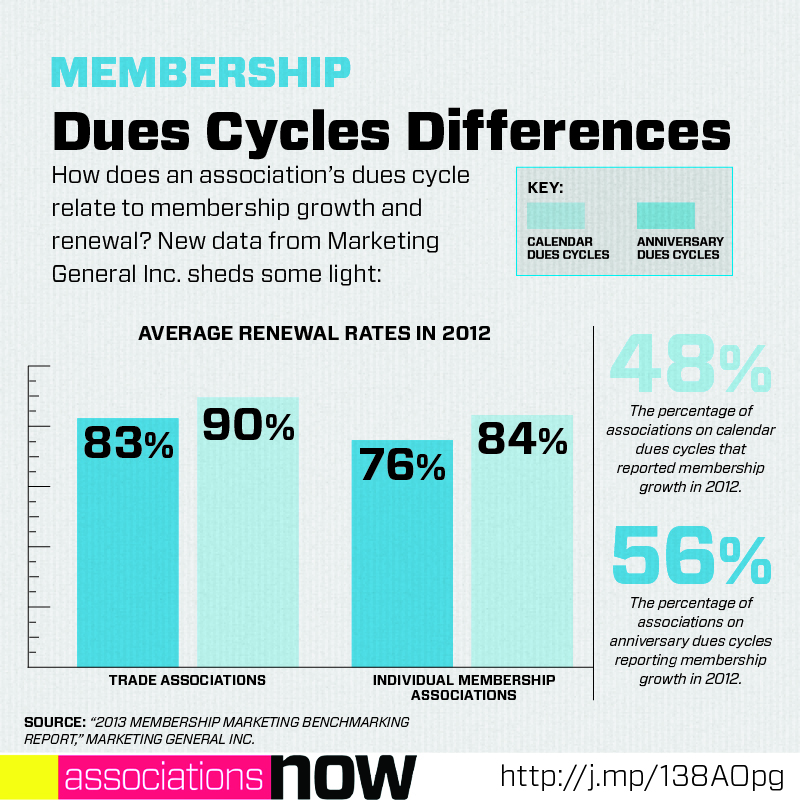
Dues Cycles and Membership Metrics
How does your choice in dues cycle relate to your association's membership growth and renewal? New data adds some new factors to weigh in the decision.
Last fall, we posed the question “yearly or year-round?” in Associations Now, exploring data on association dues cycles. In that article and in a follow-up blog post, data from ASAE’s benchmarking studies showed that anniversary dues cycles (join any time, renew one year later) were more prevalent among individual membership organizations (IMOs) and larger associations, while calendar dues cycles (everyone renews on a fixed date) were more prevalent in trade associations and small-staff organizations.
But how do those different types of dues cycles relate to member recruitment and renewal? Now we have some answers.
Associations on anniversary dues cycles were more likely to have seen an overall increase in membership in 2012, but associations on calendar cycles showed a higher average renewal rate.
Marketing General, Inc., published its “2013 Membership Marketing Benchmarking Report” in June (see “Report: Many Associations Saw Membership Jump in 2013” for highlights), and it included a new question this year about the style of membership renewal that participating associations use. The responses aligned to ASAE’s data in relation to trade/IMO and small/large, but the correlation with recruitment and retention is where it gets interesting:

So, in short, associations on anniversary dues cycles were more likely to have seen an overall increase in membership in 2012 than those on calendar cycles, but associations on calendar cycles showed a higher average renewal rate. [Note: The data on renewals appears on page 25 of the MGI report; the data on membership growth comes from the same study but was not included in the report.]
Before you run off to change your dues cycle model, first remember the old adage about correlation and causation. Tony Rossell, senior vice president at MGI, says some underlying dynamics about different types of associations are also at play:
- Trade associations and smaller associations, which are more likely to be on a fixed-date calendar cycle, also typically have higher renewal rates than their IMO or large counterparts.
- Similarly, calendar cycles are more common among older, more traditional associations that tend to have more stable, year-to-year membership levels.
- Meanwhile, the largest associations, with 20,000 members or more, were the most likely to have anniversary cycles.
And there’s also an important relationship between new-member acquisition and renewal rates: “New members are always the lowest renewing category, so the higher your new-member input is, generally speaking the lower your renewal rate is,” Rossell says. “Anniversary groups tend to have reported more membership growth in the last year than fixed-year groups, so they would have more new members and maybe less qualified new members. To get into a fixed-year group, you have to work a little harder to get in.”
In Associations Now last fall, Wes Trochlil, president of Effective Database Management, pointed out that more and more association management software (AMS) platforms can automate much of the join-and-renewal process, which makes anniversary cycles more feasible. And larger associations are both more likely to need automated systems due to their sheer member volume and more likely to have the resources to deploy such systems.
Automated, anniversary membership cycles also make it easier to add new members. But more new members generally means lower renewal rates a year later. Perhaps what we’re seeing here is that the anniversary cycle opens the door for a bit more volatility in membership numbers—more churn at the margin among easy-come, easy-go members.
All of this is to say that there are a lot of factors to consider in deciding which dues cycle is the best fit for your association. Rossell says he recommends the anniversary cycle as long as it’s feasible. “From a consumer perspective, a consumer’s expectation for best practice would be ‘I could join whenever I want to join, and I’ll pay for one year and get renewed a year later.’ And anniversary allows for year-round marketing and takes prorating of dues off the table,” he says. “So, in general, my recommendation would be if you can operationally manage it with your staff and technology, it’s the right way to go.”
Have you made a switch from one dues cycle to another? If so, did you see changes in any metrics like recruitment and retention or in management costs and time? What other factors does your association consider in its choice of dues cycle?
(iStockphoto/Thinkstock)






Comments